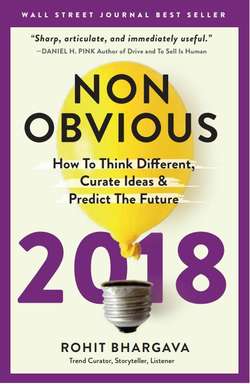Читать книгу Non-Obvious 2018 Edition - Рохит Бхаргава - Страница 65
Proving Questions: How to Quantify a Trend
Оглавление1 Is the trend idea unique enough to stand out?
2 Has anyone published research related to this trend idea?
3 Is the media starting to uncover examples or focus on it?
4 Are there enough examples across industries?
5 Is the trend likely to continue into the foreseeable future?
In your own efforts to curate trends, when you go through this list of questions—it’s possible you’ll find that some of the trend ideas that you’ve curated, analyzed, elevated, and even created names for may not satisfy all these criteria.
Unfortunately, you have now reached the toughest step in the Haystack Method: leaving behind trends that you cannot prove. Abandoning ideas is brutal—especially after you have become attached to them. It probably won’t help that in this chapter I’ve already advised you to name them before you prove them—which seems logically wrong. You never name something you’re going to leave behind, right?
Well, as true as that may be, the problem is that you need to name the trends before you can assess its importance. The process of naming helps you understand what a trend is and how you might prove it, but it doesn’t mean you’re finished.
This is the phase of the process where I find discipline. It forces me to go back and either do more research and sometimes even change the original concept of the trend to be broader or narrower.
Grading all the past identified trends (see Appendix) was eye opening when my team and I first decided to add it in the 2016 edition of the book. It was clear that the trends where we had more discipline in the proving phase were the ones that fared better over time. Those were the best ideas, and the ones that you can and should aspire to have, too.
